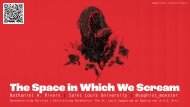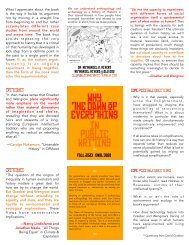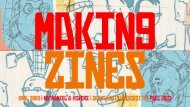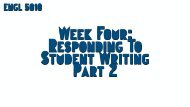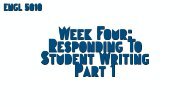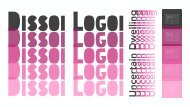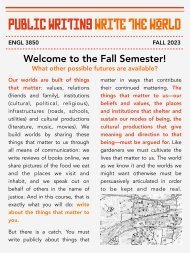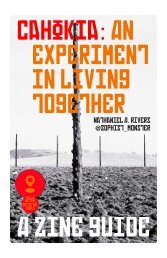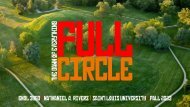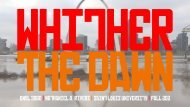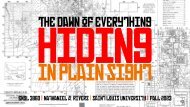ENGL 4010: Course Intro Slide Deck (SP23)
You also want an ePaper? Increase the reach of your titles
YUMPU automatically turns print PDFs into web optimized ePapers that Google loves.
Planetary Sensing<br />
English <strong>4010</strong>
<strong>Intro</strong>duction<br />
How can we use digital media to not only write about the world but to also change how the world<br />
shows up for us—to change how we see, hear and touch the world (and senses beyond even<br />
these)? That is the central question for this course, and it is the primary work of this course as well.<br />
To focus that work, this course will take up the concerns of environmental justice and<br />
climate collapse. We find ourselves in a moment wherein our individual and collective capacity to<br />
sense the environment and environmental change is vitally important. How can we render<br />
ourselves and others sensitive to the environment in ways that generate meaningful responses to<br />
problems such as environmental injustice and climate collapse?<br />
Students will develop a collaborative research project built around the sensing capacities<br />
of a digital tool and directed toward a local environmental issue. How can one deploy<br />
microphones to investigate the presence or absence of animal life in a particular location? How<br />
can one utilize aerial photography (e.g., a drone) to map access to green spaces? How can one<br />
use social media (e.g., Twitter) to trace the health concerns of individuals near damaged or<br />
otherwise unhealthy environments? Student research projects will culminate in a<br />
sophisticated and compelling report collaboratively composed to persuasively address<br />
(and possibly redress) their chosen environmental issue.
<strong>Course</strong> Projects<br />
Social Annotation & Participation<br />
We share our thoughts on course readings by using Hypothes.is, an online annotation application.<br />
Annotations vary from person-to-person, but our overriding goal is to share reactions, questions,<br />
interests, and dis/beliefs through annotating our readings together. Annotations take the form of<br />
comments, questions, intra- and inter-connections, and links. Annotations, crucial, add to the<br />
readings.<br />
The Issue Survey<br />
This 1,000 word document briefly surveys the issue you plan on researching. At minimum, the<br />
survey should define the contours of your issue (e.g., themes, locations, human and nonhuman<br />
actors, history, stakes, etc.). This isn't yet your research proposal or plan, but it should lead you to<br />
the research questions and methods you subsequently develop.<br />
The Logbook<br />
Following Jennifer Gabrys in How to Do Things with Sensors and drawing from Sara Pink and<br />
others, this 2,000 word document should meticulously outline what and, more importantly, how<br />
you are researching: the methods, digital and analog tools, research questions, key terms, actors<br />
(human and nonhuman), events, locations, and sources you employ/deploy.
<strong>Course</strong> Projects<br />
The Report<br />
Near the conclusion of your (field) research, you begin designing and writing your final report,<br />
which should be a sophisticated and compelling document composed to persuasively address<br />
(and possibly redress) your chosen social issue. The details of this document will be discussed in<br />
more detail later, but it is important to note here that the expectations for this document are<br />
exceptionally high. We devote at least a month to drafting, designing, laying out and revising this<br />
report. I fully expect this to be one of the most challenging pieces of rhetoric and writing<br />
you have so far produced at SLU. To that end, of course, I promise to provide the tools,<br />
instruction, and scaffolding necessary to insure your success.<br />
The Research Binder<br />
At the conclusion of this course, you submit a research binder. This binder includes every piece of<br />
paper you generate over the course of the semester. The binder is thus a living archive. As an<br />
archive, it should have an organizational scheme that makes it accessible to both you and your<br />
instructor. Individual entries should be dated and described (e.g., quiz, reading-journal, notes,<br />
etc.). In addition to labeling individual entries, the binder itself should be organized in a coherent,<br />
compelling and accessible way. As an archive, it should trace the work of cultivating yourself as a<br />
researcher and writer.
<strong>Course</strong> Projects<br />
30%<br />
10%<br />
5%<br />
15%<br />
40%<br />
Issue Survey<br />
Logbook<br />
Report<br />
Research Binder<br />
Social Annotation
Calendar




